Colony Management – Feral Cat Set-Up for Long-Term Holding
The following guidelines are provided by Feral Cat FOCUS.
Sometimes a feral cat needs to be confined for an extended period of time. Situations include a mom cat raising young kittens, a serious injury like a bite wound or broken limb that needs time to heal, or an illness that requires a course of antibiotics.
The worst thing anyone could do in a long-term foster situation is let the cat out into a room, even the bathroom. A feral cat released in this manner will either go find a place to hide, often a spot you never knew existed, or literally start climbing the walls trying to escape. You lose all control over their movement and when the time comes to transport them out of the room, trying to get them into a carrier will be outright dangerous and trapping them difficult.
The FERAL CAT SETUP, with its carrier inside a cage, is a much safer way to go.
MATERIALS NEEDED
- Crate – at least 42 in – 48 in
- Small cat carrier with swinging and lockable front door
- Small litter pan
- Litter
- Yardstick or broomstick handle
- Cotton sheet
- Newspaper/Cardboard
- Food and water dishes
- Twist tie
- Small towel
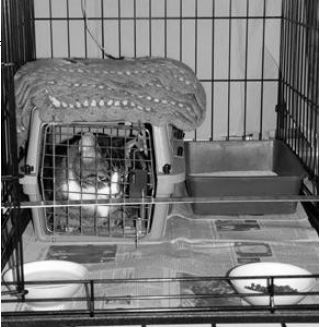
THE SETUP (WITHOUT THE CAT)
Fully assembled, the Feral Cat Setup appears as in Figure 1.
Line the bottom of the cage with newspaper/cardboard.
Place the carrier in one back corner of the cage – whether left or right depends on which direction the carrier door opens. Make sure the carrier door, when it’s open, rests against the side of the cage and doesn’t swing open into the middle.
Side by side to the carrier in the other rear corner is the litter pan. Ideally, the pan should fit fairly tight against the side of the carrier, helping to keep the carrier in place.
Food and water dishes are placed towards the front of the cage near the cage door.
A sheet covers part or the entire cage.
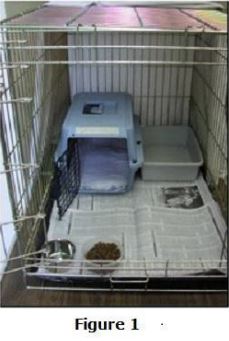
PLACING THE CAT INSIDE THE FERAL CAT SETUP
The way not to place a cat inside the Feral Cat Setup is to try to move the cat directly from a trap to inside the cage. This is very risky because at the moment both the trap door and cage door are open, all the cat has to do is exit the trap, twist around and take off. You won’t be able to pull back the trap and shut the cage door in time to stop him.
Instead, the trick is to already have the cat inside the small carrier, then simply place the carrier inside the cage.
If the cat is coming back from a visit to the veterinarian or spay/neuter clinic, give the carrier (with a towel inside) to the veterinary staff and ask them to put the cat in there while he’s still sedated.
ONCE THE CAT IS IN THE CARRIER FOLLOW THESE STEPS
- Place the carrier containing the cat into the rear corner of the cage, left or right corner depending on which way the carrier door opens (Figure 2).
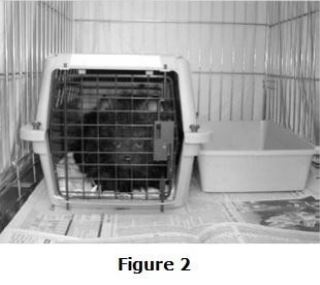
- Slide the yardstick through both sides of the cage so it bars the carrier door from opening (Figure 3).

- Unlock the carrier door (Figure 4). Use a plate or a book to shield your hand if you’re concerned about getting scratched.
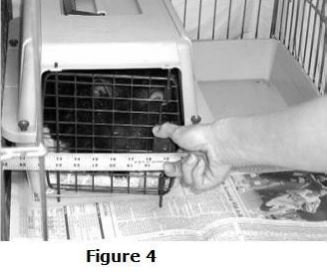
- Place food and water at the front of the cage.
- Close and lock the cage door.
- Remove the yardstick and use it to reach into the cage through the bars (it’s easiest from above) and maneuver the carrier door open until the door is resting against the side of the cage.
- Use the twist tie to secure the carrier door against the side of the cage (Figure 5).
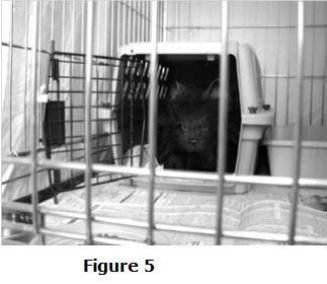
- Cover the cage partially or fully with the cotton sheet to calm the cat.
FEEDING AND CLEANING
Once the cat is inside the Feral Cat Setup and the carrier door is open, he’s free to move about, eat, poop, scatter the litter, shred the newspaper/cardboard, tip over the water dish, etc.
You will need to regularly feed and clean. In order for you to safely open the cage door and clean up, the cat must be inside the carrier. Normally, this is not a problem because feral cats will spend most of their time in the carrier to begin with as it’s the only tight, dark space available. If they happen to be out of the carrier when you want to get in the cage, they’ll usually head straight back inside as soon as they see you approaching.
If they start to get comfortable and don’t go in, you may have to coax them. Unfolding more of the sheet that’s covering the cage might work. Other tricks include making a loud sound, tapping the side of the cage, poking gently with the yardstick or spraying a very small amount of water at them. If these don’t work and the cat won’t move into the carrier, wait and try again later. Do not open the cage door if the cat is out.
ONCE THE CAT IS INSIDE CARRIER, FOLLOW THESE STEPS
- Untie the carrier door from the side of the cage.
- Using the yardstick, maneuver the carrier door shut.
- Bar carrier door by sliding the yardstick through both sides of the cage just in front of the carrier door.
- Open the cage door.
- For extra security, lock the carrier door.
- Clean up and leave food in front.
- Unlock the carrier door, using a plate or book to avoid scratches.
- Close and lock the cage door
- Remove the yardstick
- Use the yardstick to maneuver the carrier door open.
- Twist-tie the carrier door to the side of the cage.
- Cover the cage partially or fully with the sheet.
NOTE: If you prefer, you can remove the carrier with the cat inside while you’re cleaning, of course after you’ve locked the carrier door. When you’re finished straightening up, put the carrier back inside, bar the door with the yardstick, unlock the carrier door, close the cage door, etc.
